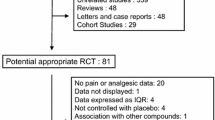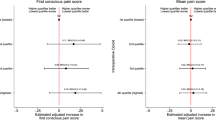Abstract
Background
The effects and analgesic adequacy of intrathecal morphine (ITM) administration have been studied less frequently than other regional analgesia techniques in pediatric surgical procedures.
Objective
To evaluate the efficacy and adverse event rate of 5 µg/kg ITM administration for postoperative analgesia according to age group.
Methods
We retrospectively evaluated the medical records of patients who underwent major pediatric surgery and were administered ITM for postoperative analgesia. Patients were divided into three age groups: ≤ 5 years (group I), 5.1–13 years (group II) and > 13 years (group III). All patients received ITM 5 µg/kg (max 300 μg) through the L4–5 or L5–S1 interspace. Postoperative pain (modified pediatric objective pain score > 4), need for rescue analgesics, sleep interruption due to pain, sedation (Ramsay sedation scale score > 3), opioid-related postoperative adverse events (at 0, 4, 8, 12, and 24 h after intervention), hemodynamic data and nurse satisfaction with the analgesic method were compared between groups.
Results
The analysis included 100 children (47 girls, 9 ± 5.4 years). Groups were similar regarding postoperative rescue analgesia consumption and sleep interruption (p = 0.238, p = 0.958), 96% of the children did not require rescue analgesia, and sleep interruption was not observed in 97%. Postoperative adverse events were pruritus in 14 and nausea/vomiting in 9 patients (p = 0.052). Overall, nurses were satisfied or very satisfied in 99% of the cases.
Conclusion
Administration of 5 µg/kg ITM can be used for postoperative analgesia in pediatric surgery in all age groups, with no severe adverse events and high nurse satisfaction with analgesic management.
Zusammenfassung
Hintergrund
Die Auswirkungen und die analgetische Angemessenheit der Verabreichung von intrathekalem Morphin (ITM) sind im Vergleich zu anderen regionalen Analgesietechniken bei pädiatrischen chirurgischen Eingriffen weniger häufig untersucht worden.
Ziele
Die Wirksamkeit und Nebenwirkungsrate der Verabreichung von 5 µg/kg ITM zur postoperativen Analgesie in Abhängigkeit von den Altersgruppen werden bewertet.
Methoden
Wir haben die medizinischen Aufzeichnungen von pädiatrischen Patienten, die sich einer größeren pädiatrischen Operation unterzogen haben und denen ITM zur postoperativen Analgesie verabreicht wurde, retrospektiv ausgewertet. Die Patienten wurden in 3 Altersgruppen eingeteilt: ≤ 5 Jahre (Gruppe I), 5,1–13 Jahre (Gruppe II) und > 13 Jahre (Gruppe III). Alle Patienten erhielten ITM 5 µg/kg (max. 300 µg) durch den Zwischenraum L4–5 oder L5–S1. Postoperativer Schmerz (modifizierter pädiatrischer objektiver Schmerzscore > 4), Notwendigkeit von Notfallanalgetika, Schlafunterbrechung aufgrund von Schmerzen, Sedierung (Ramsay Sedation Scale Score > 3), opioid-bedingte postoperative Nebenwirkungen (bei 0, 4, 8, 12 und 24 h nach der Intervention), hämodynamische Daten und die Zufriedenheit des Pflegepersonals mit der analgetischen Methode wurden zwischen den Gruppen verglichen.
Ergebnisse
Die Analyse beinhaltete 100 Kinder (47 Mädchen, Durchschnittsalter 9 ± 5,4 Jahre; Durchschnitt ± Standardabweichung). Die Gruppen ähnelten sich hinsichtlich des postoperativen Rescue-Analgesiekonsums und der Schlafunterbrechung (p = 0,238 and p = 0,958), 96 % der Kinder benötigten keine Rescue-Analgesie und eine Schlafunterbrechung wurde bei 97 % der Kinder nicht beobachtet. Postoperative Nebenwirkungen waren Pruritus bei 14 (Gruppe I: 8,1 %; Gruppe II: 10,8 % und Gruppe III: 26,9 %); Übelkeit/Erbrechen bei 9 (Gruppe I: 2,7 %; Gruppe II: 8,1 % und Gruppe III: 19,2 %) Patienten (p = 0.052). Insgesamt war die Zufriedenheit des Pflegepersonals in 99 % der Fälle auf dem Niveau „zufrieden“ oder „sehr zufrieden“.
Diskussion
ITM in einer Dosis von 5 µg/kg kann zur postoperativen Analgesie bei pädiatrischen chirurgischen Eingriffen in allen Altersgruppen, ohne schwerwiegende Nebenwirkungen und unter hoher Zufriedenheit des Pflegepersonals mit der Schmerzmittelbehandlung eingesetzt werden.

Similar content being viewed by others
References
Tobias JD, Deshpande JK, Wetzel RC et al (1990) Postoperative analgesia. Use of intrathecal morphine in children. Clin Pediatr 29(1):44–48
Srinivasan AK, Shrivastava D, Kurzweil RE et al (2016) Port site local anesthetic infiltration vs single-dose intrathecal opioid injection to control perioperative pain in children undergoing minimal invasive surgery: a comparative analysis. Urology 97:179–183
Apiliogullari S, Duman A, Gok F et al (2009) Efficacy of a low-dose spinal morphine with bupivacaine for postoperative analgesia in children undergoing hypospadias repair. Paediatr Anaesth 9(11):1078–1083
Eschertzhuber S, Hohlrieder M, Keller C et al (2008) Comparison of high- and low-dose intrathecal morphine for spinal fusion in children. Br J Anaesth 100(4):538–543
Jones SE, Beasley JM, MacFarlane DW et al (1984) Intrathecal morphine for postoperative pain relief in children. Br J Anaesth 56:137–140
Miller RD, Eriksson LI, Fleisher LA et al (2015) Miller’s anesthesia, 8th edn. Elsevier Saunders, Philadelphia, pp 1711–1712 (Chapter 56)
Garimella V, Cellini C (2013) Postoperative pain control. Clin Colon Rectal Surg 26:191–196
Hindle A (2008) Intrathecal opioids in the management of acute post operative pain. Cont Educ Anaesth Crit Care Pain 8(3):81–85
Hong RA et al (2017) A retrospective comparison of intrathecal morphine and epidural hydromorphone for analgesia following posterior spinal fusion in adolescents with idiopathic scoliosis. Paediatr Anaesth 27(1):91–97
Krechel WS, Helikson MA, Kittle D, Eggers GWN (1995) Intrathecal morphin for postoperative pain in children: a comparison with nalbuphine for patient controlled analgesia. Paediatr Anaesth 5:177–183
Goodarzi M (1998) The advantages of intrathecal opioids for spinal fusion in children. Paediatr Anaesth 8:131–134
Ganesh A, Kim A, Casale P et al (2007) Low-dose intrathecal morphine for postoperative analgesia in children. Anesth Analg 104:271–276
Suominen P, Ragg P, McKinley D et al (2004) Intrathecal morphine for postoperative analgesia in children following cardiac surgery. Acta Anaesthesiol Scand 48:875–882
Gall O, Aubineau J‑V, Berniere J et al (2001) Analgesic effect of low dose intrathecal morphine after spinal fusion in children. Anesthesiology 94:447–452
Gehling M, Tryba M (2009) Risks and side-effects of intrathecal morphine combined with spinal anaesthesia: a meta-analysis. Anaesthesia 64(6):643–651
Cravero JP, Agarwal R, Berde C et al (2019) The Society for Pediatric Anesthesia recommendations for the use of opioids in children during the perioperative period. Paediatr Anaesth 29(6):547–571
Bourdaud N, Devys JM, Bientz J et al (2014) Development and validation of a risk score to predict the probability of postoperative vomiting in pediatric patients: the VPOP score. Paediatr Anaesth 24(9):945–952
Berger AS, Goldschneider KR (2019) The role of neuraxial opioids in pediatric practice. Clin J Pain 35(6):497–500
Kremer WI, Rose JB (2009) Pharmacologic management of acut pediatric pain. Anesthesiol Clin 27:241–268
Sultan P, Gutierrez MC, Carvalho B (2011) Neuraxial morphine and respiratory depression: finding the right balance. Drugs 71(14):1807–1819
Cohen M, Zuk J, McKay N et al (2017) Intrathecal morphine versus extended-release epidural morphine for postoperative pain control in pediatric patients undergoing posterior spinal fusion. Anesth Analg 124:2030–2037
Li Y, Hong RA, Robbins CB et al (2018) Intrathecal morphine and oral analgesics provide safe and effective pain control after posterior spinal fusion for adolescent idiopathic scoliosis. Spine 43:98–104
Tripi PA, Poe-Kochert C, Potzman J et al (2008) Intrathecal morphine for postoperative analgesia in patients with idiopathic scoliosis undergoing posterior spinal fusion. Spine 33:2248–2251
Rawal N, Mollefors K, Axelsson K et al (1983) An experimental study of urodynamic effects of epidural morphine and of naloxone reversal. Anesth Analg 62:641–647
Wheeler M, Oderda GM, Ashburn MA, Lipman AG (2002) Adverse events associated with postoperative opioid analgesia: a systematic review. J Pain 3(3):159–180
Funding
There was no external funding for conducting the study and the preparation of this manuscript.
Author information
Authors and Affiliations
Corresponding author
Ethics declarations
Conflict of interest
G. Keskin, M. Akın, Y. Şenaylı, C.İ. Öztorun and M. Bahçecitapar declare that they have no competing interests.
For this article no studies with human participants or animals were performed by any of the authors. All studies performed were in accordance with the ethical standards indicated in each case.
Additional information

Scan QR code & read article online
Rights and permissions
About this article
Cite this article
Keskin, G., Akın, M., Şenaylı, Y. et al. Effects of 5 µg/kg intrathecal morphine for postoperative analgesia in pediatric patients undergoing major surgery. Anaesthesiologie 71 (Suppl 2), 212–218 (2022). https://doi.org/10.1007/s00101-021-01040-4
Received:
Revised:
Accepted:
Published:
Issue Date:
DOI: https://doi.org/10.1007/s00101-021-01040-4
Keywords
- Intrathecal morphine
- Pediatric postoperative analgesia
- Pruritus
- Nausea and vomiting
- Pediatric anesthesia




